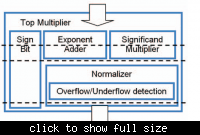shaiko
Advanced Member level 5
Hello people,
I've read an interesting post a few days ago...
Basically, it suggests that when doing logic operation that are time consuming - we should use pipelining.
For example, if we want to multyply four 32 bit wide vectors (A,B,C,D) and move the result to vector Z.
We shouldn't do Z <= A*B*C*D;
but rather:
PROCESS(Clk)
BEGIN
if(rising_edge(Clk)) then
--Implement the pipeline stages using a for loop and case statement.
--'i' is the stage number here.
--The multiplication is done in 3 stages here.
for i in 0 to 2 loop
case i is
when 0 => temp1 <= A*B;
when 1 => temp2 <= B*C;
when 2 => Z <= C*D;
when others => null;
end case;
end loop;
end if;
END PROCESS;
What I don't understand:
If we consider the first example (Z<=A*B*C*D) after some delay and "settling time" - the correct result of Z will arrive at the end. It will be "glitchy" - but only for a very short time!
After the "settling time" the product Z will be stable!
So, why should we pipeline?
I've read an interesting post a few days ago...
Basically, it suggests that when doing logic operation that are time consuming - we should use pipelining.
For example, if we want to multyply four 32 bit wide vectors (A,B,C,D) and move the result to vector Z.
We shouldn't do Z <= A*B*C*D;
but rather:
PROCESS(Clk)
BEGIN
if(rising_edge(Clk)) then
--Implement the pipeline stages using a for loop and case statement.
--'i' is the stage number here.
--The multiplication is done in 3 stages here.
for i in 0 to 2 loop
case i is
when 0 => temp1 <= A*B;
when 1 => temp2 <= B*C;
when 2 => Z <= C*D;
when others => null;
end case;
end loop;
end if;
END PROCESS;
What I don't understand:
If we consider the first example (Z<=A*B*C*D) after some delay and "settling time" - the correct result of Z will arrive at the end. It will be "glitchy" - but only for a very short time!
After the "settling time" the product Z will be stable!
So, why should we pipeline?
